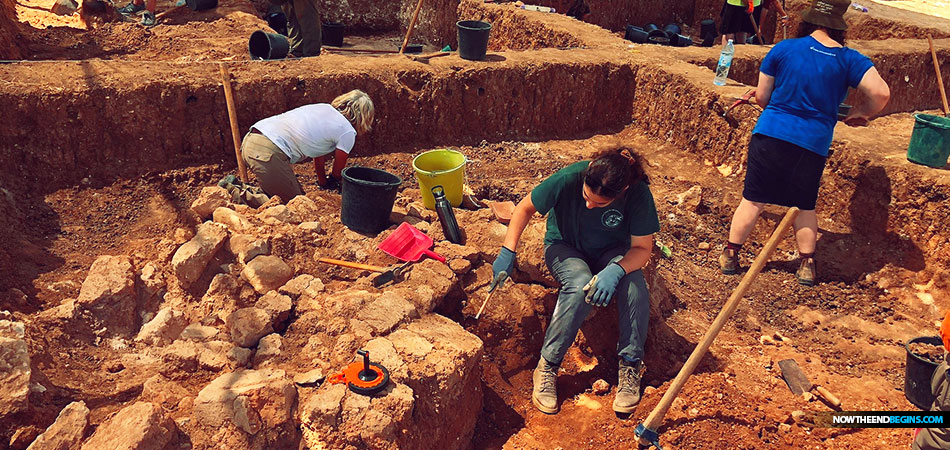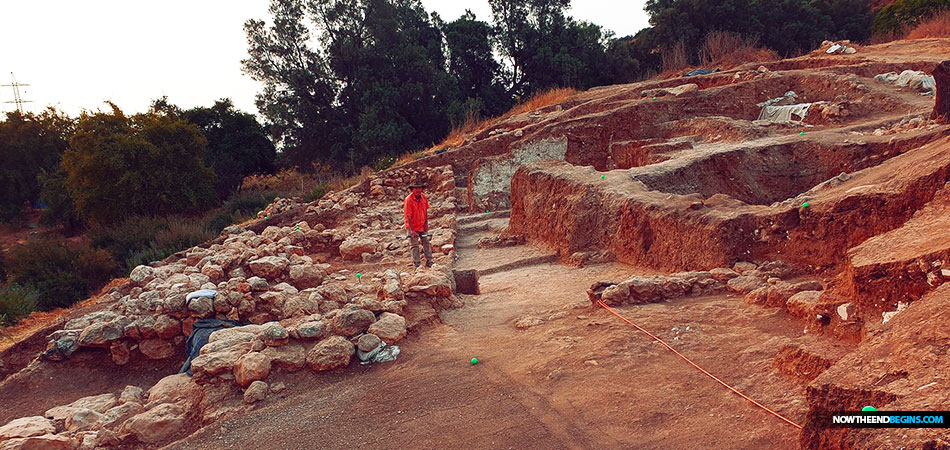
A Goliath of a man may have sprouted from an equally giant-sized city. Super-sized remains of “enormous” architecture and fortifications from a new, unexpected “biblical-era” layer of the Philistine city of Gath were unearthed this summer at the ongoing Tell es-Safi/Gath Archaeological Project.
Digging and excavations at the site of what is believed to be the ancient biblical city of Gath have been going on for a few years now, but archaeologists have recently found an exciting 'new layer' which is shedding light on Gath actually being the home of Goliath and his fellow giant brothers. Results are still being analyzed but suffice to say it is creating a buzz in the biblical archaeology community in the Middle East.
"And as he talked with them, behold, there came up the champion, the Philistine of Gath, Goliath by name, out of the armies of the Philistines, and spake according to the same words: and David heard them. And all the men of Israel, when they saw the man, fled from him, and were sore afraid." 1 Samuel 17:23,24 (KJV)
Of course, if you're a Bible believer, you
already know that Gath was the home of the giant Goliath who was slayed by the shepherd boy David, who would grow up to be the best king Israel ever had. Your 'dusty, old and archaic'
King James Bible with all its 'thees and thous' contains that truth and a thousand more just like it that science is still struggling to catch up with. Yes sir, that dime store KJV is more up-to-date than tomorrow's headlines.
Colossal ancient structures found at Gath may explain origin of story of Goliath
FROM THE TIMES OF ISRAEL: Whereas most of the site’s previously excavated areas date to the 10th and 9th centuries BCE, this new layer dates to the 11th century, when, according to the biblical narrative in 1 Samuel 17 , the future King David slew the giant Goliath.
“For those scholars that accept that David was a historical figure — and I’m among them — the late 11th-, early 10th century BCE, the time of the earlier phase of the city of Gath, whose impressive remains were just found, is the time frame in which David existed,” Bar-Ilan University Prof. Aren Maeir, the 23-year excavation director of the Tell es-Safi/Gath dig, told The Times of Israel. The dating follows the chronology of the Kings of Israel and Judah as presented in the Bible.
“If in fact David did confront an opponent in single combat, most often identified as Goliath, this would, more or less, be the time of this early Iron Age phase of the city of Gath,” said Maeir. He emphasized that “it is hard to say whether or not there is a historical kernel to the story, and if there is in fact a kernel, what this kernel was.”

View of the Water Gate at Gath, summer 2019 (Aren Maeir/Tell es-Safi/Gath Archaeological Project)
There is still no inscription conclusively stating that “this is Gath,” however the previous two decades of excavation at Tell es-Safi/Gath have uncovered a massive Iron Age Philistine site that served as the region’s center of gravity in the 9th and 10th centuries, said Maeir. The settlement was destroyed by the Aramean King Hazael around 830 BCE, which is echoed in the account of Gath that is written in Kings II 12:18.
For years, said Maeir, he and his team had assumed that the Hazael destruction layer was the largest phase of ancient Gath. “But I kept having this niggling feeling. It was bothering me: If the city destroyed by Hazael was so important, why didn’t it have fortifications? There were some, but nothing to write home about,” said Maeir.
Digging a little deeper this year, the team found impressive remains that predate the settlement destroyed by Hazael in 830 BCE, as
first reported in Haaretz.
“They show that the buildings and the fortifications were very large, built with extremely large stones,” Maeir said. The team also unearthed unusual 11th century walls constructed with very thick, well-built, burnt brick. Maeir said this type of brick is rarely used in pre-Roman times.
While beginning excavation at the 11th century site, “We got the feeling that perhaps this earlier phase is larger and dramatically more impressive than the city that was destroyed by Hazael,” he said. “It’s a surprise, but on the other hand — it explains something… The pieces fit together now much better.”
The monumental architecture is of much larger dimensions than almost anything found in the Levant during this era, said Maeir. This unexpected layer opens up the possibility that the city was a regional stronghold by the 11th century, said Maeir, as opposed to the previously assumed settlement of Ekron. As such, the find could cause a rethink of the “matrix of who were the strong powers in the region at the time,” he said.
The uncovered fortifications discovered in the lower city are 4 meters (13 feet) wide, versus the 2-2.5 meter (6.5-8 foot) wide walls discovered from later periods. Likewise, the dimensions of the building material itself are dramatically different. In later layers at the site, said Maeir, the ancient architects used half-meter-long (1.6 foot) stones. In the “Goliath layer,” the blocks measure between one and two meters (roughly 3.2-6.5 feet).
The 11th century city was outstandingly large and would have covered an area of 500 dunams (123.5 acres) — more than twice the area of most comparable cities in the Levant, said Maeir. For point of reference, when ancient Jerusalem was at its height a few hundred years later, it would have reached 400-500 dunams, he said.
“In geographical terms, Gath was a ‘primate city’ and on a larger and different scale than others,” said Maeir, comparing it to the difference between New York City versus Indianapolis.
In addition to the gigantic building discovery, Maeir and his team also uncovered several 3,000-year old rooms that appear to be fortifications created just prior to the Hazael conquest. The 9th or 10th century mudbrick rooms were filled with earth, which preserved their 2 meter-high plastered walls and doorways leading to other rooms. It is unusual to have such high walls made of intact sun-dried bricks, he said.
This summer’s dig has just concluded. According to the project’s
well-updated website,2021 will mark the 25th and final season. “You excavate a site so for long that you think you understand it,” said Maeir. “But every turn of the trowel can bring a new and unexpected find.”
READ MORE
No comments:
Post a Comment